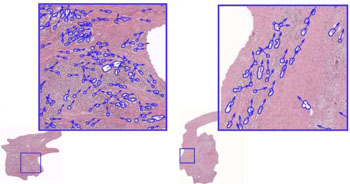Benign Tissue Structural Features Predict Risk of Prostate Cancer Recurrence Following Surgery
By LabMedica International staff writers
Posted on 18 Jul 2016
A preliminary study found that evaluation of a collection of structural features observed in normal tissues surrounding a prostate tumor was a better predictor of risk of recurrence of the cancer following surgical removal of the tumor by radical prostatectomy (RP).Posted on 18 Jul 2016
Gleason scoring represents the standard for diagnosis of prostate cancer (PCa) and assessment of prognosis following RP. A Gleason score is given to prostate cancer based upon its microscopic appearance. Cancers with a higher Gleason score are more aggressive and have a worse prognosis. The method is based on H&E-stained immunohistochemistry sections using antibody 34betaE12, reactive against basal cell–specific high-molecular-weight cytokeratins.

Image: In benign tissue next to a prostate tumor, the orientation of prostate glands, tends to be more uniform in those at low risk for biomedical recurrence but disordered among those at high risk (Photo courtesy of Case Western Reserve University).
Investigators at Case Western Reserve University (Cleveland, OH, USA) and Johns Hopkins University (Baltimore, MD, USA) suggested that Gleason scoring did not account for structural patterns in neighboring normal-appearing benign fields that might be more predictive of disease recurrence.
To examine the predictive value of benign tissue structural features, the investigators analyzed records from 70 patients who had undergone RPs from 2000 to 2004 with up to 14 years follow-up. The investigators digitized images of the resected prostate specimens and analyzed the tumor regions and surrounding tissues that appeared to be benign. The top 10 features identified as most predictive of recurrence within both the benign and cancerous regions were combined into a 10-feature signature (tumor plus adjacent benign signature or TABS). Computer-extracted nuclear shape and architectural features from cancerous regions, adjacent benign fields, and TABS were evaluated with various statistical tools.
Among the patient group, 22 experienced prostate cancer recurrence in the form of biochemical recurrence (increase in PSA levels), metastasis, or death. In all cases tumor-adjacent benign field features were predictive, with tumor-field nuclear shape descriptors and benign-field local nuclear arrangement being the most useful features found for TABS. Combining TABS with a Gleason sum further improved prediction of recurrence. Overall, nuclear shape and architecture in the benign-looking tissue were greater predictors of recurrence than features found in the tumor.
"In a sense, this study is validating what a lot of people think regarding these cancers - that there is a field effect, as if the tumor has hard-to-see tentacles that can affect the patient and outcomes," said senior author Dr. Anant Madabhushi, professor of biomedical engineering at Case Western Reserve University. "There is a clear path to a clinical/translational test. There is no destruction of tissue - nothing to stop us from analyzing the images and specimens and coming up with a risk score."
The study was published in the June 16, 2016, online edition of the journal European Urology Focus.
Related Links:
Case Western Reserve University
Johns Hopkins University














